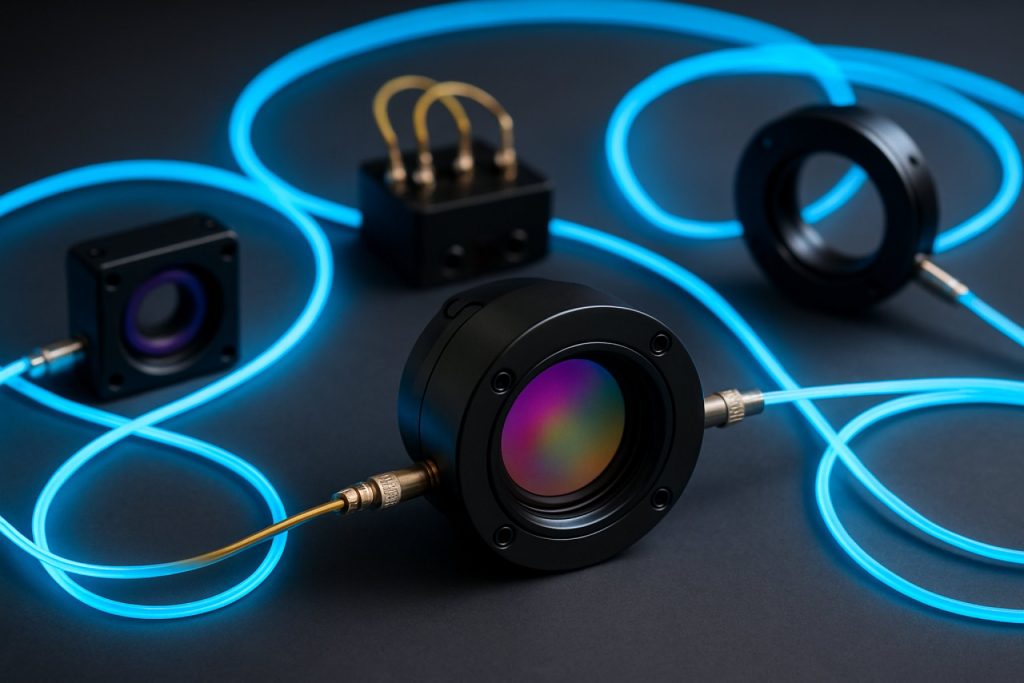
Distributed Quantum Sensing Devices Market Report 2025: In-Depth Analysis of Growth Drivers, Technology Innovations, and Global Opportunities. Explore Market Size, Competitive Dynamics, and Forecasts Through 2030.
- Executive Summary and Market Overview
- Key Technology Trends in Distributed Quantum Sensing Devices
- Market Size, Segmentation, and Growth Forecasts (2025–2030)
- Competitive Landscape and Leading Players
- Regional Analysis: North America, Europe, Asia-Pacific, and Rest of World
- Emerging Applications and Use Cases
- Challenges, Risks, and Market Barriers
- Opportunities and Strategic Recommendations
- Future Outlook: Innovations and Market Evolution
- Sources & References
Executive Summary and Market Overview
Distributed quantum sensing devices leverage the principles of quantum mechanics—such as entanglement and superposition—to enable highly sensitive, networked measurements across spatially separated locations. These devices are rapidly emerging as a transformative technology in fields ranging from navigation and geophysics to defense and telecommunications. By connecting multiple quantum sensors, distributed quantum sensing systems can achieve measurement precisions unattainable by classical means, offering significant advantages in detecting weak signals, synchronizing time, and mapping physical environments.
The global market for distributed quantum sensing devices is projected to experience robust growth through 2025, driven by increasing investments in quantum technologies and the rising demand for ultra-precise measurement solutions. According to IDTechEx, the quantum sensing market—including distributed architectures—is expected to surpass $1.2 billion by 2025, with distributed systems representing a rapidly expanding segment due to their scalability and enhanced performance.
Key industry players such as Qnami, MagiQ Technologies, and Q-CTRL are actively developing distributed quantum sensing platforms, targeting applications in secure communications, environmental monitoring, and infrastructure diagnostics. Government initiatives, particularly in the US, EU, and China, are further accelerating market development through substantial funding and collaborative research programs. For instance, the European Quantum Flagship program has allocated significant resources to distributed quantum sensing research, aiming to establish Europe as a leader in quantum-enabled technologies (Quantum Flagship).
- In defense, distributed quantum sensors are being explored for submarine detection, navigation in GPS-denied environments, and secure battlefield communications (DARPA).
- In geoscience, these devices enable high-resolution mapping of gravitational fields and underground structures, supporting resource exploration and seismic monitoring (Nature).
- Telecommunications providers are investigating distributed quantum sensors for ultra-precise time synchronization and network monitoring (Deutsche Telekom).
Despite technical challenges—such as maintaining entanglement over long distances and integrating quantum devices with classical infrastructure—the market outlook for distributed quantum sensing devices in 2025 is highly optimistic. Ongoing advancements in quantum networking, photonics, and error correction are expected to further unlock commercial opportunities and drive adoption across multiple sectors.
Key Technology Trends in Distributed Quantum Sensing Devices
Distributed quantum sensing devices leverage the principles of quantum mechanics—such as entanglement and superposition—to enable highly sensitive, spatially distributed measurements across networks. In 2025, the field is witnessing rapid technological advancements, driven by both academic research and commercial investment. These devices are increasingly being deployed in applications ranging from navigation and geophysics to secure communications and environmental monitoring.
One of the most significant trends is the integration of quantum entanglement across sensor networks, which allows for enhanced measurement precision beyond classical limits. Recent demonstrations have shown that entangled photon sources can be distributed over fiber-optic networks, enabling synchronized and correlated measurements at distant locations. This capability is being actively explored by organizations such as National Institute of Standards and Technology (NIST) and Centre for Quantum Technologies, which are developing protocols for robust entanglement distribution and error correction in real-world environments.
Another key trend is the miniaturization and integration of quantum sensors using photonic and solid-state platforms. Advances in integrated photonics are enabling the fabrication of compact, chip-scale quantum sensors that can be deployed in large numbers across distributed networks. Companies like Qnami and MagiQ Technologies are pioneering the commercialization of such devices, focusing on scalable manufacturing and field-deployable solutions.
Quantum networking protocols are also evolving to support distributed sensing. The development of quantum repeaters and quantum memory technologies is critical for extending the range and reliability of entanglement distribution. Efforts by IBM Quantum and Quantinuum are pushing the boundaries of quantum network infrastructure, which is essential for the practical deployment of distributed quantum sensing systems.
Finally, there is a growing emphasis on hybrid classical-quantum architectures, where quantum sensors are integrated with classical data processing and machine learning algorithms. This approach enhances the interpretability and utility of quantum-enhanced measurements, particularly in complex environments such as urban infrastructure monitoring and autonomous navigation. The convergence of quantum hardware and advanced software is expected to accelerate the adoption of distributed quantum sensing devices in 2025 and beyond, as highlighted in recent market analyses by IDC and Gartner.
Market Size, Segmentation, and Growth Forecasts (2025–2030)
The global market for distributed quantum sensing devices is poised for significant expansion between 2025 and 2030, driven by advancements in quantum technologies and increasing demand for ultra-sensitive measurement solutions across various industries. Distributed quantum sensing leverages entangled quantum states across spatially separated sensors, enabling unprecedented precision in applications such as navigation, geophysical exploration, and secure communications.
According to projections by IDTechEx, the quantum sensing market—including distributed architectures—is expected to surpass $1.2 billion by 2030, with distributed devices accounting for a rapidly growing share due to their scalability and enhanced performance. The compound annual growth rate (CAGR) for distributed quantum sensing devices is estimated to exceed 30% during the forecast period, outpacing the broader quantum sensing segment as pilot projects transition to commercial deployments.
Market segmentation reveals several key application domains:
- Defense and Security: Distributed quantum sensors are being adopted for navigation in GPS-denied environments, submarine detection, and secure perimeter monitoring. Agencies such as the Defense Advanced Research Projects Agency (DARPA) are investing heavily in field trials and prototype development.
- Telecommunications: Quantum-enhanced distributed fiber sensing is gaining traction for real-time monitoring of critical infrastructure, with companies like BT Group and Deutsche Telekom piloting quantum-secured networks and distributed sensing overlays.
- Geoscience and Environmental Monitoring: Distributed quantum gravimeters and magnetometers are being deployed for oil and gas exploration, earthquake prediction, and climate research, with support from organizations such as the National Aeronautics and Space Administration (NASA).
- Healthcare and Biomedical: Early-stage research is exploring distributed quantum sensors for high-resolution imaging and biomagnetic field detection, with academic-industry partnerships accelerating innovation.
Regionally, North America and Europe are leading in R&D and early commercialization, while Asia-Pacific is expected to witness the fastest growth due to government-backed quantum initiatives and expanding industrial applications (McKinsey & Company).
In summary, the distributed quantum sensing devices market is set for robust growth from 2025 to 2030, underpinned by technological breakthroughs, expanding use cases, and increasing investment from both public and private sectors.
Competitive Landscape and Leading Players
The competitive landscape for distributed quantum sensing devices in 2025 is characterized by a dynamic mix of established technology conglomerates, specialized quantum startups, and academic spin-offs, all vying for leadership in a rapidly evolving market. The sector is witnessing increased investment and strategic partnerships, as companies seek to leverage quantum entanglement and networked sensor arrays for applications in navigation, defense, environmental monitoring, and healthcare.
Key players include IBM, which has expanded its quantum research initiatives to encompass distributed sensing platforms, and Thales Group, leveraging its expertise in defense and aerospace to develop quantum-enhanced navigation and detection systems. Qnami, a Swiss startup, is notable for its quantum sensor technology based on nitrogen-vacancy centers in diamond, which is being adapted for distributed architectures. MagiQ Technologies and Qnami are also recognized for their early commercialization of quantum sensing solutions.
In the UK, Quantum Communications Hub and National Quantum Computing Centre (NQCC) are fostering collaboration between academia and industry, accelerating the translation of research into deployable distributed quantum sensors. Meanwhile, Lockheed Martin and Northrop Grumman are investing in quantum sensing for defense and aerospace, focusing on secure navigation and surveillance.
- Strategic Partnerships: The market is marked by alliances between quantum hardware developers and end-user industries. For example, Thales Group has partnered with European research institutions to advance distributed quantum gravimeters and magnetometers.
- Startups and Spin-offs: Companies like Qnami and MagiQ Technologies are pushing the boundaries of miniaturization and network integration, aiming for scalable, field-deployable solutions.
- Government and Defense: National initiatives, such as the US National Quantum Initiative and the EU Quantum Flagship, are providing funding and infrastructure, enabling both established and emerging players to accelerate product development and commercialization.
Overall, the distributed quantum sensing device market in 2025 is highly competitive, with innovation driven by cross-sector collaboration, government support, and a race to achieve practical, scalable deployment across critical industries.
Regional Analysis: North America, Europe, Asia-Pacific, and Rest of World
The regional landscape for distributed quantum sensing devices in 2025 is marked by significant disparities in technological maturity, investment levels, and market adoption across North America, Europe, Asia-Pacific, and the Rest of the World. Each region demonstrates unique drivers and challenges shaping the deployment and commercialization of these advanced sensing systems.
North America remains at the forefront of distributed quantum sensing innovation, propelled by robust funding from both government and private sectors. The United States, in particular, benefits from strategic initiatives such as the National Quantum Initiative Act, which has catalyzed research and commercialization efforts. Leading institutions and companies, including IBM and NIST, are actively developing quantum sensor networks for applications in defense, infrastructure monitoring, and environmental sensing. The region’s strong ecosystem of quantum startups and established tech giants is expected to drive the North American market to a dominant share in 2025, with a focus on early pilot deployments and government contracts.
Europe is characterized by a collaborative approach, with the European Union’s Quantum Flagship program fostering cross-border research and industrial partnerships. Countries such as Germany, the UK, and the Netherlands are investing heavily in quantum sensing R&D, with organizations like Vodafone and Thales Group exploring distributed quantum sensor networks for secure communications and critical infrastructure. The region’s regulatory emphasis on data privacy and security is also shaping the development of quantum-enhanced sensing solutions, positioning Europe as a leader in standardization and interoperability by 2025.
- Asia-Pacific is witnessing rapid growth, led by China, Japan, and South Korea. China’s government-backed quantum initiatives, such as those spearheaded by Chinese Academy of Sciences, are accelerating the deployment of distributed quantum sensors in urban monitoring and national security. Japan’s focus on industrial automation and South Korea’s investments in telecommunications are further expanding the regional market. The Asia-Pacific region is expected to see the fastest CAGR through 2025, driven by aggressive public and private sector investments.
- Rest of the World encompasses emerging markets in Latin America, the Middle East, and Africa, where adoption is nascent but growing. Limited infrastructure and funding remain challenges, but pilot projects—often in partnership with international organizations—are beginning to emerge, particularly in resource monitoring and smart city applications.
Overall, while North America and Europe are leading in terms of technological sophistication and market readiness, Asia-Pacific’s rapid expansion and the gradual emergence of the Rest of the World signal a broadening global footprint for distributed quantum sensing devices in 2025.
Emerging Applications and Use Cases
Distributed quantum sensing devices are rapidly transitioning from laboratory prototypes to real-world applications, driven by advances in quantum networking, photonics, and miniaturization. In 2025, several emerging use cases are demonstrating the transformative potential of these devices across industries.
- Precision Navigation and Timing: Distributed quantum sensors are being deployed to enhance navigation systems, particularly in environments where GPS is unreliable or unavailable. By leveraging entangled quantum states across spatially separated sensors, these systems achieve unprecedented accuracy in time synchronization and inertial navigation, which is critical for autonomous vehicles, aerospace, and defense applications. Defense Advanced Research Projects Agency (DARPA) has initiated pilot programs integrating quantum-enhanced inertial sensors into military platforms.
- Environmental and Geophysical Monitoring: Networks of quantum sensors are being used to detect minute changes in gravitational fields, magnetic anomalies, and seismic activity. This distributed approach enables early warning systems for earthquakes and volcanic eruptions, as well as more accurate resource exploration. Projects in Europe, such as the UK Quantum Technology Hub Sensors and Timing, are deploying quantum gravimeters for urban infrastructure monitoring and subsurface mapping (UK Quantum Technology Hub Sensors and Timing).
- Secure Distributed Sensing: Quantum entanglement provides inherent security advantages, making distributed quantum sensors attractive for critical infrastructure monitoring. For example, quantum key distribution (QKD) is being combined with sensor networks to ensure tamper-proof data transmission in energy grids and communication networks. Toshiba Corporation has demonstrated prototype systems integrating QKD with distributed fiber-optic sensors.
- Healthcare and Biomedical Imaging: Quantum-enhanced distributed sensors are emerging in medical diagnostics, enabling higher sensitivity in magnetoencephalography (MEG) and magnetic resonance imaging (MRI). These advances promise earlier disease detection and improved brain-computer interface technologies, with pilot studies underway at leading research hospitals (Nature Scientific Reports).
As these use cases mature, the market for distributed quantum sensing devices is expected to expand rapidly, with industry analysts forecasting double-digit annual growth rates through the late 2020s (IDTechEx). The convergence of quantum networking, advanced materials, and AI-driven data analytics is likely to unlock further applications, solidifying distributed quantum sensing as a foundational technology for the next decade.
Challenges, Risks, and Market Barriers
Distributed quantum sensing devices, while promising transformative advances in precision measurement and detection, face a range of significant challenges, risks, and market barriers as of 2025. These obstacles span technical, economic, regulatory, and ecosystem-related domains, collectively shaping the pace and scale of market adoption.
- Technical Complexity and Scalability: The deployment of distributed quantum sensors requires robust entanglement distribution and synchronization across multiple nodes, often over long distances. Maintaining quantum coherence and minimizing decoherence in real-world environments remains a formidable challenge. Current quantum networks are limited in scale and reliability, with Nature highlighting persistent issues in photon loss, noise, and error correction.
- High Development and Deployment Costs: The cost of developing, manufacturing, and maintaining quantum sensing devices is substantially higher than that of classical sensors. Specialized materials, cryogenic cooling, and advanced photonic components drive up capital expenditures. According to Boston Consulting Group, the high upfront investment required for quantum infrastructure is a key barrier for widespread commercial adoption.
- Standardization and Interoperability: The lack of universally accepted standards for quantum communication protocols and device interfaces impedes integration into existing sensor networks. This fragmentation increases the risk of vendor lock-in and complicates the development of scalable, interoperable solutions, as noted by ETSI.
- Regulatory and Security Concerns: Quantum sensing devices, especially those with potential defense or surveillance applications, are subject to stringent export controls and regulatory scrutiny. The dual-use nature of quantum technologies raises concerns about proliferation and misuse, prompting governments to consider new frameworks for oversight, as discussed by OECD.
- Talent Shortage and Ecosystem Maturity: There is a pronounced shortage of skilled professionals with expertise in quantum engineering, photonics, and cryogenics. The nascent state of the quantum technology ecosystem limits the availability of supply chain partners and service providers, slowing innovation and commercialization, according to McKinsey & Company.
Addressing these challenges will require coordinated efforts across industry, academia, and government to advance research, develop standards, and foster a robust quantum technology ecosystem.
Opportunities and Strategic Recommendations
The market for distributed quantum sensing devices in 2025 is poised for significant growth, driven by advancements in quantum technologies and increasing demand for ultra-precise measurement solutions across various sectors. Key opportunities are emerging in fields such as defense, telecommunications, environmental monitoring, and healthcare, where distributed quantum sensors can offer unprecedented sensitivity and resilience against interference.
One of the most promising opportunities lies in the integration of quantum sensors into existing fiber-optic networks. This approach leverages the widespread infrastructure of telecommunications providers, enabling large-scale deployment of distributed quantum sensing for applications such as seismic monitoring, intrusion detection, and structural health assessment. Companies like BT Group and Deutsche Telekom are already exploring quantum-enhanced network services, indicating a strong commercial interest in this direction.
In the defense sector, distributed quantum sensing devices are being evaluated for their potential to detect stealth objects, submarines, and other threats with higher accuracy than classical systems. Governments and defense contractors, including Lockheed Martin and BAE Systems, are investing in quantum sensor R&D, creating opportunities for technology providers to form strategic partnerships and secure long-term contracts.
Environmental monitoring is another high-growth area, with distributed quantum sensors enabling real-time detection of minute changes in magnetic, gravitational, or chemical fields. This capability is particularly valuable for early warning systems in earthquake-prone regions and for monitoring critical infrastructure such as dams and bridges. Organizations like the U.S. Geological Survey are potential end-users for these solutions.
Strategic recommendations for market participants in 2025 include:
- Form alliances with telecom operators to accelerate the integration of quantum sensors into existing networks.
- Collaborate with government agencies and defense contractors to co-develop application-specific solutions and secure funding.
- Invest in R&D to improve device miniaturization, robustness, and interoperability with classical systems.
- Engage in standardization efforts through organizations such as the International Telecommunication Union to ensure compatibility and foster market adoption.
- Target early-adopter markets, such as critical infrastructure monitoring and high-value defense applications, to build credibility and demonstrate ROI.
By capitalizing on these opportunities and following targeted strategic recommendations, stakeholders can position themselves at the forefront of the distributed quantum sensing device market as it matures in 2025 and beyond.
Future Outlook: Innovations and Market Evolution
The future outlook for distributed quantum sensing devices in 2025 is marked by rapid innovation and a dynamic market evolution, driven by advances in quantum technologies, increased investment, and expanding application domains. Distributed quantum sensing leverages entanglement and quantum correlations across spatially separated sensors, enabling unprecedented sensitivity and precision in measurements for fields such as navigation, geophysics, and secure communications.
In 2025, the market is expected to witness the emergence of more robust and scalable quantum sensor networks, propelled by breakthroughs in quantum networking and photonic integration. Companies and research institutions are focusing on miniaturization and integration of quantum sensors with classical infrastructure, aiming to facilitate real-world deployment. For instance, the integration of quantum sensors with fiber-optic networks is anticipated to enable distributed sensing over metropolitan and even continental scales, opening new commercial opportunities in infrastructure monitoring and environmental sensing ID Quantique.
Key industry players are investing in the development of portable and user-friendly quantum sensing devices, targeting sectors such as defense, energy, and healthcare. The defense sector, in particular, is expected to be an early adopter, utilizing distributed quantum sensors for applications like submarine detection and GPS-independent navigation DARPA. Meanwhile, the energy sector is exploring quantum-enhanced seismic monitoring for oil and gas exploration, as well as grid stability management Shell.
On the innovation front, 2025 is likely to see the commercialization of quantum-enhanced distributed magnetometers and gravimeters, with several pilot projects already underway in Europe and North America Quantum Communications Hub. These devices promise to outperform classical counterparts in sensitivity and resilience to environmental noise, making them attractive for critical infrastructure monitoring and scientific research.
Market evolution is also being shaped by increased public and private funding, with governments in the US, EU, and Asia-Pacific launching dedicated quantum technology initiatives and fostering public-private partnerships European Commission. As standardization efforts mature and interoperability challenges are addressed, the distributed quantum sensing market is poised for significant growth, with analysts projecting a compound annual growth rate (CAGR) exceeding 30% through the late 2020s MarketsandMarkets.
Sources & References
- IDTechEx
- Qnami
- MagiQ Technologies
- Q-CTRL
- Quantum Flagship
- DARPA
- Nature
- Deutsche Telekom
- National Institute of Standards and Technology (NIST)
- Centre for Quantum Technologies
- IBM Quantum
- Quantinuum
- IDC
- BT Group
- National Aeronautics and Space Administration (NASA)
- McKinsey & Company
- Thales Group
- Quantum Communications Hub
- National Quantum Computing Centre (NQCC)
- Lockheed Martin
- Northrop Grumman
- Vodafone
- Chinese Academy of Sciences
- Toshiba Corporation
- International Telecommunication Union
- ID Quantique
- Shell
- European Commission
- MarketsandMarkets



